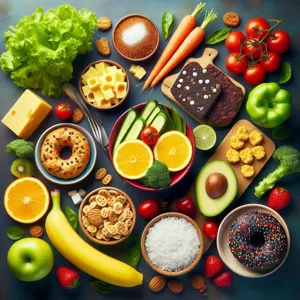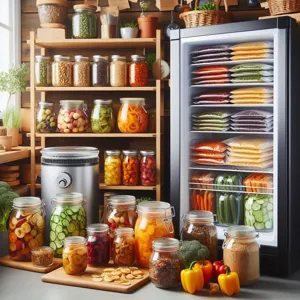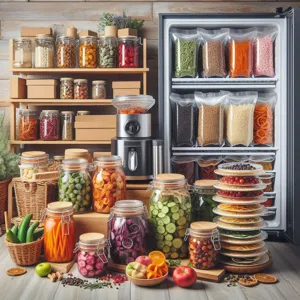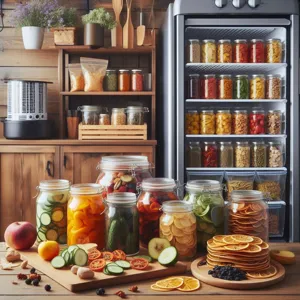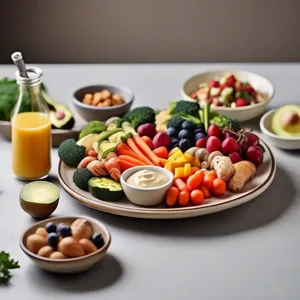In a world overflowing with processed snacks and fast food options, the journey towards a healthier lifestyle can often feel overwhelming.
However, embracing the vibrant world of whole foods can transform not only your meals but also your overall well-being. Whole foods, rich in nutrients and free from artificial additives, offer a plethora of benefits that can enhance your energy levels, improve digestion, and boost your immune system. If you’re looking to make a positive shift in your diet but aren’t sure where to start, you’re in the right place! In this blog post, we will explore 10 simple yet effective strategies to seamlessly incorporate more whole foods into your daily routine. From easy meal prepping tips to creative ways to enhance your favorite dishes, these strategies will empower you to savor the natural flavors of wholesome ingredients while fostering a healthier relationship with food. Get ready to embark on a delicious journey towards nourishing your body and mind!
1. Understanding Whole Foods: What Are They?

Before diving into the myriad benefits of whole foods and how to seamlessly incorporate them into your daily meals, it’s essential to grasp what whole foods actually are. At their core, whole foods are those that are minimally processed and free from artificial substances. They are the foods that come closest to their natural state, retaining their inherent nutrients and flavors.
Think of whole foods as the vibrant fruits and vegetables that color your grocery store’s produce section, the hearty grains that fill your pantry, and the lean meats or plant-based proteins that can be grilled or sautéed to perfection. Whole foods include items like fresh berries bursting with antioxidants, crisp leafy greens teeming with vitamins, wholesome legumes packed with fiber, and nuts that provide a crunchy dose of healthy fats.
In contrast, processed foods often contain additives, preservatives, and refined ingredients that can diminish their nutritional value. When you choose whole foods, you’re opting for nourishment that supports your overall health—foods that can boost your energy levels, enhance your mood, and even improve your digestion.
Understanding whole foods is the first step in transforming your diet. By prioritizing these nutrient-dense options, you can create meals that are not only delicious but also beneficial for your body. So, as you embark on this journey of incorporating more whole foods into your diet, keep in mind that each choice you make is a step toward a healthier, more vibrant you.
2. The Benefits of Eating Whole Foods
Embracing whole foods in your diet can transform not just your meals but also your overall health and well-being. Whole foods—those that are minimally processed and free from artificial ingredients—offer a wealth of benefits that go far beyond mere nourishment. One of the most significant advantages is their nutrient density. Whole foods, such as fruits, vegetables, whole grains, nuts, and legumes, are packed with vitamins, minerals, and antioxidants that support bodily functions, strengthen the immune system, and promote longevity.
Furthermore, incorporating whole foods into your meals can lead to improved digestion. Foods rich in fiber, like leafy greens and whole grains, help maintain a healthy gut, regulate blood sugar levels, and promote a feeling of fullness, which can aid in weight management. Unlike processed foods, which often contain added sugars and unhealthy fats, whole foods provide sustained energy, keeping you energized and focused throughout the day.
Additionally, eating whole foods can have a positive impact on mental health. Studies have shown that diets rich in whole foods can reduce the risk of depression and anxiety, likely due to the balanced nutrients that support brain function and emotional well-being. By prioritizing whole foods, you not only nourish your body but also uplift your mood and cognitive performance.
Lastly, choosing whole foods fosters a deeper connection to the food you consume. It encourages mindfulness in eating, as you become more aware of where your food comes from and how it impacts your health. This conscious approach to eating can lead to better choices in the long run, paving the way for a healthier lifestyle. So, as you consider incorporating more whole foods into your diet, remember the multitude of benefits waiting to enrich not just your plate, but your life as well.
3. Start with a Whole Foods Pantry Makeover

Transforming your pantry is one of the most effective ways to incorporate more whole foods into your diet. Begin by emptying out your pantry shelves and scrutinizing each item. As you assess your collection, ask yourself: Is this food nourishing? Does it contribute to my health goals? This inventory will give you a clear picture of what you currently have and what you need to replace.
Next, bid farewell to processed snacks, sugary cereals, and canned goods filled with preservatives. Letting go of these items not only creates physical space for healthier options but also helps shift your mindset toward more wholesome choices. Consider donating unopened items to local food banks or sharing with friends who might appreciate them.
Now, it’s time to restock! Fill your pantry with vibrant whole foods that are rich in nutrients. Opt for staples like whole grains—think quinoa, brown rice, and oats—as well as an array of legumes such as lentils, chickpeas, and black beans. Don’t forget to include an assortment of nuts and seeds, which provide healthy fats and protein.
When it comes to condiments, swap out sugary sauces and dressings for natural options like olive oil, apple cider vinegar, and spices. These simple changes not only enhance the flavor of your meals but also keep your pantry stocked with ingredients that align with your health goals.
By revitalizing your pantry, you create an inviting environment that makes it easier to whip up wholesome meals. With a well-stocked pantry, you’ll find yourself reaching for healthier options instinctively, paving the way for a more nourishing lifestyle. Remember, the first step to a healthier diet starts at home, and your pantry makeover is the perfect place to begin!
4. Meal Planning: Creating Balanced Whole Food Meals
Meal planning is a powerful tool that can transform your approach to incorporating whole foods into your diet. By taking the time to plan your meals for the week, you not only save time and reduce stress but also ensure that you’re consistently making nutritious choices. Start by setting aside a few moments each week to brainstorm meal ideas that prioritize whole foods—think fresh fruits, vegetables, whole grains, lean proteins, and healthy fats.
Begin your meal planning journey by mapping out a balanced plate for each day. Aim for a colorful variety of vegetables and fruits, which not only enhances the visual appeal of your meals but also maximizes the range of vitamins and minerals you consume. Incorporate whole grains like quinoa, brown rice, or farro as a hearty base for your dishes. Lean proteins such as grilled chicken, baked fish, or plant-based alternatives like lentils and chickpeas will keep you satiated and energized.
To streamline your meal prep, create a shopping list based on your planned meals. This will help you avoid impulse purchases and ensure that your kitchen is stocked with the ingredients you need for delicious, whole food meals. When it’s time to cook, consider preparing larger batches of meals that can be easily reheated throughout the week, like soups, stews, or grain bowls, allowing you to enjoy home-cooked goodness even on the busiest of days.
Don’t forget to be creative and flexible with your meal planning. If you discover a new seasonal vegetable at the market or have leftover ingredients from a previous meal, integrate them into your plans. By making meal planning a regular practice, you’ll find it easier to maintain a whole food diet that nourishes both your body and your palate. Plus, the satisfaction of crafting balanced meals from scratch will inspire you to continue making healthier choices in the long run.
5. How to Shop for Whole Foods on a Budget

Shopping for whole foods on a budget is not only attainable but can also be a rewarding experience. With a bit of planning and strategizing, you can fill your pantry with nutrient-dense foods without breaking the bank. Here are some practical tips to help you make the most of your grocery trips while keeping your wallet in check.
First, consider creating a meal plan for the week. By mapping out your meals in advance, you’ll minimize impulse purchases and ensure that you buy only what you need. Focus on whole foods that can be used in multiple dishes, such as grains, legumes, and seasonal vegetables. This not only enhances your diet but also maximizes the use of your ingredients.
Next, take advantage of local farmers’ markets and community-supported agriculture (CSA) programs. These venues often provide fresh, organic produce at competitive prices, and buying in-season fruits and vegetables can lead to significant savings. Plus, you’ll be supporting local farmers and enjoying food at its peak freshness.
Don’t overlook bulk buying as a strategy for saving money on whole foods. Many grocery stores offer bulk bins for grains, nuts, seeds, and dried fruits. Purchasing these items in larger quantities can lead to substantial savings, especially if you can share with friends or family members. Just make sure to store them properly to maintain freshness.
Another savvy tip is to keep an eye out for sales and discounts. Many stores have weekly specials on fresh produce and whole foods. Use store apps or flyers to identify the best deals and plan your shopping trip around them. Additionally, consider joining loyalty programs to earn points or discounts on future purchases.
Lastly, don’t shy away from frozen and canned whole foods. Frozen fruits and vegetables are often just as nutritious as their fresh counterparts and can be more affordable. Canned beans, tomatoes, and whole grains can also be great pantry staples that are budget-friendly and versatile.
By incorporating these strategies into your shopping routine, you can enjoy a diverse array of whole foods while keeping your costs manageable. With a little creativity and planning, you’ll find that eating well doesn’t have to be expensive.
6. Easy Whole Food Snack Ideas
Snacking can often feel like a minefield of processed options, but incorporating whole foods into your snack routine is both simple and satisfying. By choosing snacks that are nutritious and wholesome, you not only fuel your body but also enhance your overall well-being. Here are some easy whole food snack ideas that are delicious, convenient, and perfect for any time of the day.
1. **Fresh Fruit**: Nature’s candy is always a winning choice! Apples, bananas, berries, and oranges are not only portable but also packed with essential vitamins and fiber. Pair them with a spoonful of almond butter or a sprinkle of cinnamon for an extra twist.
2. **Veggies and Hummus**: Crisp, colorful vegetables like carrots, bell peppers, and cucumbers make the perfect dippers for creamy hummus. Not only are you filling your belly with fiber-rich veggies, but you’re also getting a dose of healthy fats and protein from the chickpeas.
3. **Nuts and Seeds**: A handful of raw or lightly roasted nuts and seeds can be a powerhouse of nutrients. Almonds, walnuts, pumpkin seeds, and sunflower seeds are all excellent choices. They provide healthy fats, protein, and a satisfying crunch. Just be mindful of portion sizes, as they are calorie-dense.
4. **Greek Yogurt with Toppings**: Opt for plain Greek yogurt and add your favorite toppings—fresh fruit, a drizzle of honey, or a sprinkle of granola. This snack is not only rich in protein but also promotes gut health with its probiotics.
5. **Rice Cakes with Nut Butter**: For a crunchy snack, spread almond or peanut butter on whole grain rice cakes. Top them with banana slices or a dash of chia seeds for added texture and nutrition.
6. **Homemade Energy Balls**: These no-bake snacks are easy to make and customizable. Combine oats, nut butter, honey, and your choice of add-ins like dark chocolate chips, dried fruit, or coconut flakes. Roll them into bite-sized balls, and you have a quick snack ready to go.
7. **Popcorn**: Air-popped popcorn is a whole grain snack that’s high in fiber and low in calories. Sprinkle with a bit of sea salt or your favorite seasoning blend for a tasty treat that satisfies those crunchy cravings.
By incorporating these simple, whole food snack ideas into your daily routine, you’ll find it easier to nourish your body while enjoying delicious flavors. Not only do these snacks keep hunger at bay, but they also support a healthier lifestyle, ensuring you feel your best throughout the day.
7. Incorporating More Fruits and Vegetables Daily

Incorporating more fruits and vegetables into your daily diet is one of the simplest yet most effective strategies for enhancing your overall health. Packed with vitamins, minerals, and antioxidants, these natural powerhouses not only nourish your body but also contribute to disease prevention and improved well-being. The key to making fruits and vegetables a staple in your meals lies in creativity and accessibility.
Start your day by adding a variety of fruits to your breakfast. Whether it’s a handful of berries sprinkled over your oatmeal, a banana blended into your smoothie, or sliced avocado on your toast, the options are endless. As you move through your day, aim to fill half your plate with colorful vegetables at lunch and dinner. Consider roasting a medley of seasonal produce like bell peppers, carrots, and zucchini tossed in olive oil and herbs for a delicious side dish or adding a vibrant salad loaded with greens, tomatoes, cucumbers, and a sprinkle of nuts for crunch.
Snacking is another excellent opportunity to increase your fruit and vegetable intake. Keep convenient options like baby carrots, cucumber slices, or apple wedges readily available for quick grabs between meals. You can also experiment with dips, such as hummus or yogurt-based dressings, to make these snacks more enticing.
Finally, don’t forget about the power of meal prep. By washing, chopping, and storing fruits and vegetables in clear containers in your fridge, you’ll create a visual reminder to incorporate them into your meals. Try to explore new varieties or seasonal produce each week to keep your palate excited and your diet diverse. By consciously integrating more fruits and vegetables into your daily routine, you’ll not only enhance your meals but also cultivate a healthier lifestyle.
8. Cooking Methods for Preserving Nutrients in Whole Foods
When it comes to incorporating more whole foods into your diet, the cooking methods you choose can greatly influence the nutritional value of your meals. Many traditional cooking techniques can inadvertently strip away essential vitamins and minerals, while others can enhance the benefits of the foods you prepare. To ensure you’re getting the most out of your whole food ingredients, consider the following nutrient-preserving cooking methods.
**Steaming:** This gentle cooking method is one of the best ways to preserve nutrients, particularly in vegetables. Steaming allows food to cook through the use of water vapor, which helps retain vitamins that are often lost in boiling. Tender yet vibrant, steamed vegetables maintain their color, flavor, and nutritional profile, making them a delightful addition to any meal.
**Sautéing:** Using a small amount of healthy fat, such as olive or coconut oil, can enhance the flavor of your ingredients while also promoting the absorption of fat-soluble vitamins—like A, D, E, and K. Sautéing is quick, allowing you to prepare vegetables and proteins efficiently while preserving their nutrients. Just be careful not to overcook them; a few minutes on medium heat is often all it takes to achieve a perfect texture.
**Roasting:** Roasting can be a delicious way to cook whole foods, especially root vegetables and proteins. The dry heat of the oven caramelizes the natural sugars in foods, enhancing their flavor without the need for excessive added fats or sugars. To maximize nutrient retention, consider roasting at lower temperatures and for shorter times, which helps to lock in essential vitamins.
**Blanching:** If you’re planning to freeze your vegetables, blanching is an excellent pre-treatment. This method involves briefly boiling the veggies and then rapidly cooling them in ice water. Blanching not only helps preserve nutrients but also brightens colors and enhances flavors. Plus, it can reduce the enzyme activity that can lead to nutrient loss during storage.
**Raw Preparation:** Don’t underestimate the power of raw foods! Many fruits and vegetables are packed with enzymes and nutrients that are best preserved when they are not cooked. Salads, smoothies, and simple snacks of raw fruits can provide a fresh burst of vitamins that are readily available for your body to absorb.
By selecting the right cooking methods, you can enjoy the delicious flavors of whole foods while maximizing their nutritional benefits. Experiment with these techniques to discover which ones you and your family enjoy the most, ensuring that your journey toward a healthier diet is as satisfying as it is nourishing.
9. Exploring Whole Grains: Substitutes for Refined Grains
Exploring whole grains is an essential step in transitioning to a healthier diet, as they offer a wealth of nutrients often stripped away in refined grains. Whole grains, such as quinoa, farro, barley, and brown rice, retain their bran and germ, providing fiber, vitamins, and minerals that support digestion, heart health, and sustained energy levels.
When it comes to substituting refined grains with whole grains, the options are both versatile and delicious. For instance, consider swapping out white rice for nutty brown rice or fluffy quinoa, both of which bring a rich texture and a plethora of nutrients to your plate. If you’re a pasta lover, whole grain or legume-based pastas can add a hearty dimension to your favorite dishes while increasing their fiber content.
Baking is another area where you can easily incorporate whole grains. While traditional recipes often call for all-purpose white flour, experimenting with whole wheat flour, oat flour, or almond flour can yield delicious results without sacrificing flavor. These flours not only enhance the nutritional profile of your baked goods but also introduce unique tastes and textures that can elevate your culinary creations.
Moreover, breakfast is a great opportunity to embrace whole grains. Instead of sugary cereals or refined toast, try oatmeal topped with fresh fruit and nuts, or opt for whole grain bread slathered with avocado for a satisfying start to your day.
Remember, transitioning to whole grains doesn’t have to happen overnight. Start by introducing one or two whole grain substitutes into your meals each week. As you become more familiar with their flavors and cooking methods, you’ll find it easier to explore a wider variety of these nourishing foods, ultimately enriching your diet and enhancing your overall health. Embrace the journey of incorporating whole grains, and watch how they transform your meals and your well-being!
10. Preparing Simple and Quick Whole Food Recipes
Preparing simple and quick whole food recipes is one of the most effective strategies to seamlessly incorporate more nutritious ingredients into your daily meals. In our fast-paced lives, it can be all too easy to reach for convenience foods that are often processed and lacking in nutritional value. However, with a little planning and creativity, you can whip up delicious, wholesome dishes in no time.
Start by stocking your kitchen with essential whole food staples such as brown rice, quinoa, lentils, canned beans, fresh vegetables, and fruits. These ingredients serve as a versatile foundation for countless recipes. For instance, a hearty grain bowl can be made in under 30 minutes by cooking quinoa and topping it with sautéed seasonal veggies, a protein source like chickpeas or grilled chicken, and a drizzle of homemade tahini dressing.
Smoothies are another fantastic quick option. Blend a banana, a handful of spinach, a scoop of nut butter, and your choice of milk for a nutrient-packed breakfast or snack. Soups are also a winner; simply simmer chopped vegetables with vegetable stock and herbs for a warming, nourishing meal in under a half hour.
Moreover, consider batch cooking on weekends. Prepare large portions of dishes like whole grain pasta salads or vegetable stir-fries that you can portion out for lunches and dinners throughout the week. This not only saves time but ensures you always have healthy options on hand, making it easier to avoid unhealthy temptations.
Remember, the key to enjoying whole foods is to keep your recipes simple and manageable. Embrace the beauty of fresh ingredients and let their natural flavors shine through with minimal seasoning. By dedicating a little time to preparing quick and wholesome meals, you’ll cultivate a more nourishing diet that promotes lasting health benefits, all while enjoying the satisfaction of home-cooked goodness.
11. The Importance of Reading Labels: Identifying Processed Foods
In the pursuit of incorporating more whole foods into your diet, one of the most crucial steps is learning to read labels effectively. This skill is essential for identifying processed foods, which can often sneak their way into our shopping carts disguised as healthy options. Many products boast appealing packaging and enticing claims, such as “low fat” or “all-natural,” but a closer look at the ingredients list can reveal a different story.
When you pick up a product, start by examining the ingredients list. Whole foods, such as fruits, vegetables, nuts, and grains, should typically have minimal ingredients—often just one! If you find a long list filled with unfamiliar substances, preservatives, and additives, chances are you’re dealing with a processed food. Additives can include artificial flavorings, colors, and sweeteners, which not only detract from the nutritional value but may also affect your health in the long run.
Moreover, pay attention to the order of ingredients. Ingredients are listed in descending order by weight, so if sugar, high fructose corn syrup, or other unhealthy components are at the top, it indicates that these are the primary constituents of the product. Aim to choose items where whole food ingredients take center stage—this is a clear indicator that you’re making a healthier choice.
Understanding labels empowers you to make informed decisions. By taking the time to scrutinize what you’re consuming, you can significantly reduce your intake of processed foods and enhance your overall diet with nourishing, whole foods. It’s a small but impactful change that paves the way for better health and well-being. So the next time you’re at the grocery store, remember that knowledge is power—read those labels and choose wisely!
12. Building Healthy Habits: Gradual Changes vs. Major Overhauls
When it comes to incorporating more whole foods into your diet, the approach you choose can make all the difference in your long-term success. Building healthy habits can be seen as a journey rather than a destination, and the path you take—whether it’s gradual changes or a major overhaul—will significantly impact your relationship with food.
Opting for gradual changes allows you to weave healthier choices seamlessly into your daily routine. This method is particularly effective for those who may feel overwhelmed by the idea of a complete diet transformation. Start small by swapping out one processed item in your pantry for a whole food alternative. For instance, replace white rice with quinoa or choose fresh fruit instead of sugary snacks. These minor adjustments can lead to significant improvements over time and help establish a sense of accomplishment and confidence in your choices.
Conversely, some individuals thrive on the excitement of a major overhaul. If you’re the type who enjoys a challenge, you might find that diving headfirst into a complete dietary shift invigorates your motivation. This could mean dedicating a weekend to meal prep with an emphasis on whole foods, clearing out your kitchen of processed items, and planning a week’s worth of nutrient-dense meals. While this method can yield quick results, it’s crucial to approach it with a balanced mindset to avoid burnout or feelings of deprivation.
No matter which path you choose, the key lies in consistency and self-compassion. Monitor your progress and be patient with yourself; building healthy habits is not about perfection, but about creating a sustainable lifestyle that nourishes your body and mind. Remember, whether you opt for gradual changes or a bold transformation, every step you take toward integrating more whole foods into your diet is a step toward better health. Celebrate your victories, learn from your setbacks, and embrace the journey as you cultivate a nourishing relationship with food that lasts a lifetime.
13. Finding Community: Connecting with Others Who Embrace Whole Foods
Finding community is a powerful aspect of embracing a whole foods lifestyle. As you embark on your journey toward healthier eating, connecting with like-minded individuals can provide not only inspiration but also accountability and support. In today’s fast-paced world, it’s easy to feel isolated in your dietary choices, especially when you’re surrounded by convenience foods and fast-paced dining options. However, by seeking out a community that shares your passion for whole foods, you can transform your experience into a more enriching and enjoyable one.
Start by exploring local farmers’ markets, where you can meet farmers and fellow food enthusiasts who prioritize fresh, locally-sourced produce. Engaging with vendors can lead to valuable insights about seasonal ingredients and preparation tips, and you might even forge friendships with other patrons who share your dietary interests. Additionally, consider joining community-supported agriculture (CSA) programs or food co-ops, which often foster a tight-knit community of individuals committed to whole foods.
Online platforms also offer an expansive realm for connection. Social media groups, forums, and dedicated websites focused on whole foods can be great places to exchange recipes, share meal prep ideas, and celebrate successes. Participating in online challenges or cooking classes can further enhance your engagement and introduce you to fellow enthusiasts from around the globe.
If you prefer a more personal touch, consider organizing or joining local meetups focused on whole food cooking. Whether it’s a potluck, a cooking class, or a book club centered around healthy eating, these gatherings can create a sense of camaraderie and encourage you to try new recipes and ingredients.
Surrounding yourself with a supportive community not only reinforces your commitment to whole foods but also enhances your culinary journey, making it more enjoyable and sustainable. As you share your experiences and learn from others, you’ll find that your connection to whole foods becomes deeper and more fulfilling, leading to lasting changes in your diet and lifestyle.
14. Staying Motivated: Tracking Your Progress and Celebrating Success
Staying motivated on your journey to incorporate more whole foods into your diet can often be the deciding factor in your success. One effective way to maintain that motivation is by tracking your progress. Keeping a food journal or using a mobile app to log your meals not only helps you stay accountable but also allows you to reflect on your choices. By noting down what you eat, you can identify patterns, celebrate small victories, and recognize areas for improvement.
In addition to tracking, it’s essential to celebrate your successes, no matter how small they may seem. Did you manage to swap out refined grains for whole grains this week? Celebrate that achievement! Perhaps you tried a new recipe featuring seasonal vegetables or experimented with a plant-based meal. Give yourself a pat on the back! Celebrating these milestones reinforces positive behavior and makes the journey feel rewarding rather than burdensome.
Consider creating a vibrant visual display of your progress. Use a whiteboard or a digital chart to mark your achievements—like the number of whole food meals you’ve prepared in a month or the new ingredients you’ve tried. This visual representation serves as a constant reminder of how far you’ve come and the delicious, nutritious foods you’ve incorporated into your life.
Furthermore, don’t hesitate to share your journey with friends, family, or your social media community. Sharing your goals and successes can create a support system that encourages you to keep going. You might even inspire others to join you on your whole foods journey! Remember, every step towards incorporating more whole foods is a step towards a healthier you, and it’s crucial to acknowledge and celebrate those steps along the way.
15. Overcoming Challenges: Tips for Staying Committed to Whole Foods
Incorporating whole foods into your diet can be a transformative journey, but it’s not without its challenges. Whether you’re navigating a busy lifestyle, dealing with cravings, or facing social pressures, staying committed to whole foods requires dedication and a solid strategy. Here are some practical tips to help you overcome common obstacles and maintain your commitment to a wholesome diet.
**1. Set Realistic Goals:** Transforming your eating habits takes time, so begin with achievable goals. Instead of attempting to overhaul your entire diet overnight, aim to incorporate one or two whole food meals each week. Gradually increase this number as you become more comfortable.
**2. Meal Prep for Success:** One of the most effective ways to stay on track is by preparing your meals in advance. Dedicate a few hours each week to plan and prepare your meals, ensuring you have a stock of healthy options ready to go. This not only saves time but also reduces the temptation to reach for convenience foods.
**3. Seek Support:** Surround yourself with like-minded individuals who share your commitment to whole foods. Join online communities, forums, or local groups focused on healthy eating. Sharing your experiences, recipes, and challenges can provide motivation and accountability.
**4. Listen to Your Body:** As you transition to a whole foods diet, pay close attention to how your body responds. You may experience cravings for processed foods, but it’s essential to listen to your body’s cues. Instead of giving in, try to identify what your body truly needs—are you hungry, tired, or bored? This mindfulness can help you make better choices.
**5. Experiment with New Recipes:** Break the monotony of your meals by experimenting with new whole food recipes. Explore various cuisines and cooking techniques to keep your meals exciting. The more variety you introduce, the less likely you are to crave processed options.
**6. Keep Whole Foods Visible:** Stock your kitchen with colorful fruits, vegetables, and other whole foods. Place them in clear view to remind you of your healthy choices. When hunger strikes, having nutritious snacks readily available makes it easier to avoid unhealthy temptations.
**7. Reflect on Your Progress:** Take time to reflect on your journey. Celebrate your successes, no matter how small, and recognize the positive changes you’ve made in your health and well-being. Keeping a journal or using an app to track your meals can help you visualize your progress and stay motivated.
By implementing these strategies, you can successfully navigate the challenges of adopting a whole foods lifestyle. Remember, it’s about progress, not perfection. Embrace the journey and enjoy the myriad benefits that come from nourishing your body with whole, unprocessed foods.
Incorporating more whole foods into your diet is a transformative journey that can lead to improved health, increased energy, and a greater appreciation for the natural flavors of food. We hope this blog post has equipped you with ten simple yet effective strategies to seamlessly integrate these nutritious options into your daily routine. By making small, manageable changes—whether it’s swapping out processed snacks for fresh fruits or experimenting with new grains—you can enhance not only your meals but also your overall well-being. Remember, the journey to healthier eating doesn’t have to be daunting; it’s all about progress, not perfection. Embrace the vibrant world of whole foods and enjoy the delicious benefits they bring to your life! Here’s to a healthier you, one bite at a time!












